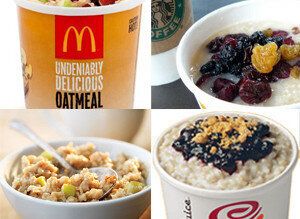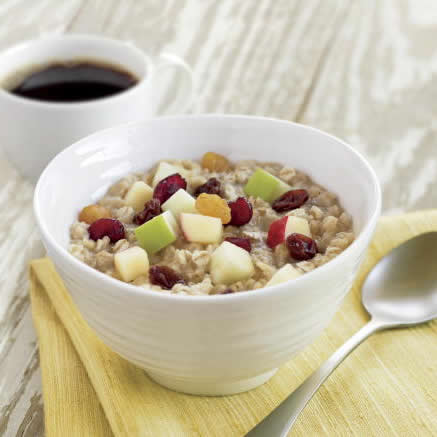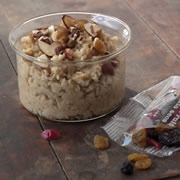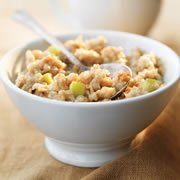

By Brierley Wright, M.S., R.D., EatingWell Nutrition Editor
Yes, Mark Bittman’s smackdown on McDonald’s oatmeal in his recent New York Times Opinionator column, “How to Make Oatmeal…Wrong,” introduced some valid points. Making your own oatmeal at home can be—and often is—healthier. (Click here for some quick and easy recipes for cooking every kind of oats.) And although its name implies it contains maple syrup, it doesn’t—it’s “natural flavor” and caramel coloring.
But as a registered dietitian and nutrition editor for EatingWell Magazine, I was disappointed by Bittman’s nutrition analysis. He only looked at the calories in McDonald’s oatmeal when he compared it to the Egg McMuffin. Sure, the Fruit & Maple Oatmeal doesn’t look so healthy when you call out the fact that it’s only 10 calories less than an Egg McMuffin. But the oatmeal looks like a much healthier choice when you see that it delivers less than half the total fat and saturated fat at 4.5 and 1.5 grams, respectively, compared to 12 and 5 in the McMuffin. In fact, the oatmeal contains the least amount of fat of any other item on the McDonald’s breakfast menu. You also get 3 more grams of fiber and 660 milligrams less sodium from the oatmeal.
And beyond all that, Bittman made no mention that oats are healthy whole grains—something that most Americans don’t eat often enough. Or that oatmeal is fiber-rich and contains protein—two key nutrients that will help keep you feeling full and satisfied until lunch. And no matter what type you choose, quick-cooking, steel-cut and rolled oats are equally healthy nutrition-wise—and can take mere minutes to cook.
More Healthy Breakfasts to Try:
Easy Slow-Cooker Oatmeal and More Healthy Recipes with Oats
11 Breakfasts That Fight Fat
McDonald’s Fruit & Maple Oatmeal has those healthy whole grains, but, to Bittman’s point, the evil is in the toppings and mix-ins (sweetened dried fruit, brown sugar and cream). For comparison, a plain 1-cup serving (cooked with water) DIY version at home delivers about 166 calories, 4 g fat, 1 g saturated fat, 9 mg sodium, 32 g carbohydrates, 4 g fiber, 6 g protein.
Though I do prefer to cook my own oatmeal—and it can be healthier—the reality is that not everyone is so willing and motivated. If you’re going to a fast-food restaurant for breakfast, oatmeal is likely to be among the healthiest picks.
Here’s a look at just how healthy—or unhealthy—the oatmeal is at some common fast-food restaurants and 4 of the healthiest choices to order. The good news? These chain restaurants’ oatmeal choices clock in at under 500 calories (some even well under), which (depending on how many calories you are, or should be, consuming) can fit into a healthy diet.

McDonald’s Fruit & Maple Oatmeal (9.2 ounces) delivers 290 calories, 4.5 g fat, 1.5 g saturated fat, 160 mg sodium, 57 g carbohydrates, 5 g fiber, 5 g protein. It’s made with a combination of instant and slower-cooked oats.
Make it a little healthier and skip the brown sugar—you’ll save 30 calories, 45 mg of sodium and 9 g of total carbohydrates.

Starbucks Perfect Oatmeal (about 8 ounces) has 140 calories, 2.5 g total fat, 0.5 g saturated fat, 105 mg sodium, 25 g total carbohydrates, 4 g fiber, 5 g protein. It’s made with quick-cooking oats.
Don’t want the plain variety? Add the Nut Medley—although it bumps the calories up to 240 (more than just adding the brown sugar and the same as adding the dried fruit) and the total and saturated fat to 11.5 g and 1.5 g, respectively (also more than the other toppings). The walnuts, pecans and almonds deliver good-for-you fats and 2 extra grams of protein, but no unhealthy added sugars as the brown sugar and sweetened dried fruit do.

Au Bon Pain Oatmeal (8 ounces) delivers 170 calories, 3 g fat, 0 g saturated fat, 5 mg sodium, 32 g total cabohydrates 4 g fiber, 6 g protein. It’s available in three different sizes—a small is 8 ounces, a medium 12 and a large 16. Although the large delivers more calories (340) than any other chain-restaurant choice, 340 calories surely won’t break the calorie bank and can still easily fit into a healthy diet.
The Apple Cinnamon variety in the same 8-ounce size has an extra 20 calories and 5 g total carbohydrates, but all other nutrient amounts are the same.
 Jamba Juice Plain Oatmeal with Brown Sugar (12 ounces) contains 220 calories, 3.5 g total fat, 1 g saturated fat, 20 mg sodium, 5 fiber, 8 g protein. The oatmeal serving is on the larger size (unless you order the medium or large at Au Bon Pain) compared to the others. Interestingly, the oatmeal is made with steel-cut oats and is the only one I found to be slow-cooked.
Jamba Juice Plain Oatmeal with Brown Sugar (12 ounces) contains 220 calories, 3.5 g total fat, 1 g saturated fat, 20 mg sodium, 5 fiber, 8 g protein. The oatmeal serving is on the larger size (unless you order the medium or large at Au Bon Pain) compared to the others. Interestingly, the oatmeal is made with steel-cut oats and is the only one I found to be slow-cooked.
The Fresh Banana Oatmeal is the flavor that adds the least amount of extra calories (12 ounces, 280 calories, 4 g total fat, 1 g saturated fat, 20 mg sodium, 57 g total carbohydrates, 6 g fiber, 9 g protein). Apple Cinnamon, Berry Cherry Pecan and Blueberry & Blackberry bump the calorie total to 290, 340 and 290, respectively—and increase sodium by a little bit in each.
Brierley's interest in nutrition and food come together in her position as an associate editor at EatingWell. Brierley holds a master's degree in Nutrition Communication from the Friedman School of Nutrition Science and Policy at Tufts University. A Registered Dietitian, she completed her undergraduate degree at the University of Vermont.
Related Links from EatingWell:
- Granola and 5 More Healthy-Sounding Foods That (Surprisingly) Aren't
- What to Buy and What to Skip at Whole Foods
- Apple-Bacon Pancakes and More Hot Breakfasts to Make At Home
- Free Menu Planner Tool, Recipe Box and More: Sign Up for My EatingWell Today!
- Love Breakfast? Swap Your Favorite Recipes and Find New Favorites in EatingWell's Online Breakfast Club
- How Many Calories Are In that Coffee? 4 Coffee-Shop Drinks to Watch Out For
- Get a free trial issue when you subscribe to EatingWell Magazine and sign up for our free e-newsletters!